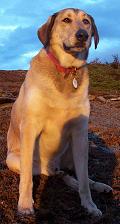Thermokarst (see picture taken on Bering Island, Russia) is surface topography that results when the ice on top of a surface u nderlain by permafrost melts creating a hummocky ground surface. Because the surface is underlain by permafrost (esentially frozen ground that never gets heated above 32F [0C]) the water from the melting surface snow and ice has no where to go, i.e. it can't just soak into the ground. So instead it tends to puddle or pond up in lower lying areas. These puddles start to melt the permafrost underneath by acting as an insulating, warming mass. As the permafrost melts the frozen ground depresses as it is consoldiated under the weight of the surface water - this is called thermokarsting. This is how a thermakarst puddle becomes a lake and how they eventually connect to each other.
nderlain by permafrost melts creating a hummocky ground surface. Because the surface is underlain by permafrost (esentially frozen ground that never gets heated above 32F [0C]) the water from the melting surface snow and ice has no where to go, i.e. it can't just soak into the ground. So instead it tends to puddle or pond up in lower lying areas. These puddles start to melt the permafrost underneath by acting as an insulating, warming mass. As the permafrost melts the frozen ground depresses as it is consoldiated under the weight of the surface water - this is called thermokarsting. This is how a thermakarst puddle becomes a lake and how they eventually connect to each other.
 nderlain by permafrost melts creating a hummocky ground surface. Because the surface is underlain by permafrost (esentially frozen ground that never gets heated above 32F [0C]) the water from the melting surface snow and ice has no where to go, i.e. it can't just soak into the ground. So instead it tends to puddle or pond up in lower lying areas. These puddles start to melt the permafrost underneath by acting as an insulating, warming mass. As the permafrost melts the frozen ground depresses as it is consoldiated under the weight of the surface water - this is called thermokarsting. This is how a thermakarst puddle becomes a lake and how they eventually connect to each other.
nderlain by permafrost melts creating a hummocky ground surface. Because the surface is underlain by permafrost (esentially frozen ground that never gets heated above 32F [0C]) the water from the melting surface snow and ice has no where to go, i.e. it can't just soak into the ground. So instead it tends to puddle or pond up in lower lying areas. These puddles start to melt the permafrost underneath by acting as an insulating, warming mass. As the permafrost melts the frozen ground depresses as it is consoldiated under the weight of the surface water - this is called thermokarsting. This is how a thermakarst puddle becomes a lake and how they eventually connect to each other. As the melting of permafrost excelerates with other warming influences (such as it not being as cold for as long of periods to refreeze the permafrost) thermokarsting increases sometiems resulting in large pieces of collapsed ground (you can see pictures of this occuring here: http://www.mines.edu/~mgooseff/web_tkarst/tkarst_proj.html). A friend of mine from grad school, Dr. Katey Walter, has studied another worrying effect of increased thermokarsting - the release of ground methane gas by releasing organic material that was trapped in the permafrost into these thaw lakes (thermokarst lakes). This methane (CH4) is then released into the atmosphere which in turn accelerates global warming even more. In addition, when thermokarsting occurs in forested regions it often leads to boggy landscapes that cannot support trees (and sometimes you get the drunken tree affect - I have pictures of this somewhere but I can't find them at the moment...).
Note: I believe you may find a more comprehensive exlaination of thermokarst in this article by De Schutter: http://ougseurope.org/rockon/surface/thermokarst.asp.



i think this is my first comment on my blog but i want you to know that i do read your blog daily from a reader. i love your posts. so informative and educational. you're one of those brainy people, aren't you, LOL. :)
ReplyDeletethat was meant to read "comment on your blog". :D
ReplyDeleteyou know.
ReplyDeletechocolate. followed by a science lesson might just lead to love.
then there is your dog. whom I covet. double love.
athena ~ oh! thanks for letting me know. I'm so glad you visit.
ReplyDeletecrazymumma ~ awww... thanks. And I agree about my Disreputable Dog, but then, I'm a bit biased.
athena ~ oh yeah...I don't know about brainy but definitely nerdy!
ReplyDeleteYay! Okay, thank you for explaining thermakarst. I understand. I showed my scientist husband this and I think you now have another reader.
ReplyDeletesally forth ~ oh yay! Which field does your scientist husband study?
ReplyDeleteThanks Wayfarer! I keep seeing karst references on the SE AK project I am working on, so I recognized the suffix, but apparently I still know rather little about it. Thanks again for the explaination. Maybe you can give me a better lesson when I come see you in a few weeks!
ReplyDeleteAnd Athena -- I've known her for 10+ years: Wayfarer is one of the nerdiest, brainiest people I know! She's great, and I am lucky to be able to call her my friend.